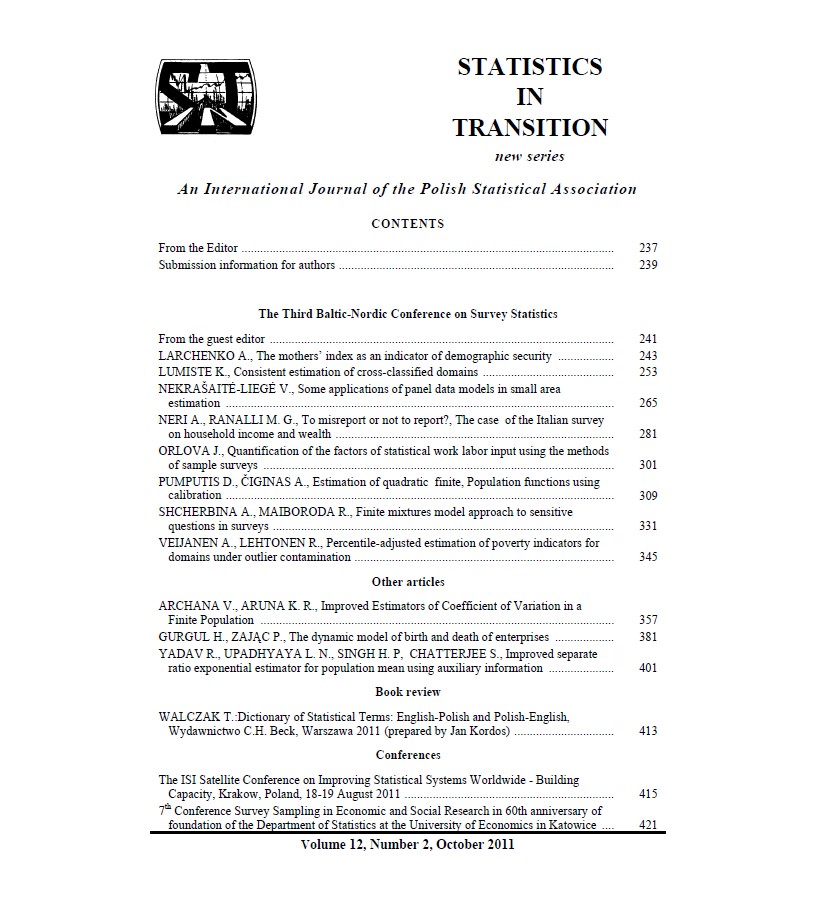ARTICLE
ABSTRACT
Observations from mixtures of different subpopulations are common in biological and sociological studies. We consider the case, when the observations are taken from a set of groups containing subjects, which belong to different subpopulations. Proportion of each subpopulation in a group is known and can vary from group to group. Our aim is to estimate the means of an observed variable for subjects, which belong to each subpopulation. In this paper we consider the case, when subpopulations are defined by answers on so called “sensitive questions”. We consider some parametric and nonparametric estimates of the subpopulation means, such as weighted means, maximum likelihood and weighted least squares estimates. Finite sample properties of these estimates are analyzed. Mean square errors of the estimates are compared on simulated data. Some asymptotic results are also given
KEYWORDS
anonymous survey; sensitive questions; maximum likelihood; weighted mean; weighted least squares
REFERENCES
BOROVKOV A.A. (1998). Mathematical statistics, Gordon and Breach Science Publishers, Amsterdam.
CHRISTOPHER C. HEYDE (1997) Quasi-Likelihood And Its Application: A General Approach to Optimal Parameter Estimation, Springer.
CHRISTOPHER G. SMALL, JINFANG WANG, (2003), Numerical Methods for Nonlinear Estimating Equations, Oxford.
COUTTS E. & JANN B. (2011), Sensitive Questions in Online Surveys:Experimental Results for the Randomized Response Technique (RRT) and the Unmatched Count Technique (UCT), Sociological Methods & Research, 40, 169-193.
KERKVLIET J. (1994) Cheating by economics students: A comparison of survey results. The Journal of Economic Education, Vol. 25, No. 2, p.121-133.
MAIBORODA R. (1996) Estimates for distributions of components of mixtures with varying concentrations. Ukrainian Mathematical Journal, 48(4), 618-622.
MAIBORODA R. (1999) An asymptotically effective probability estimator constructed from observations of a mixture. Theory Probab. Math. Stat. 59, 121-128
MAIBORODA R. & SUGAKOVA O. (2008) Estimation and classification by observations from mixtures, Kyiv University Publishers, Kyiv (in Ukrainian).
McLACKLAN G. J., PEEL D. (2000). Finite Mixture Models, Wiley, New York.
ONG A.D. and WEISS D.J. The Impact of Anonymity on Responses to Sensitive Questions. Journal of Applied Social Psychology. Volume 30, Issue 8, p. 1691–1708.
SHCHERBINA A. (2011) Mean value estimation in the model of mixture with varying concentrations. Teor. Imovir. Ta Matem. Statyst., No. 84, pp. 142-154. (In Ukrainian, English translation to appear in Theory Probab. Math. Stat).
SHCHERBINA A. (2011a) Estimation of parameters of binomial distribution in mixture model. Teor. Imovir. Ta Matem. Statyst. (In Ukrainian, English translation to appear in Theory Probab. Math. Stat).
